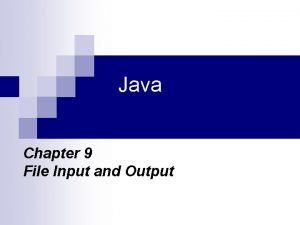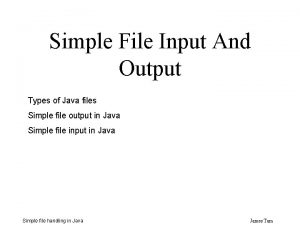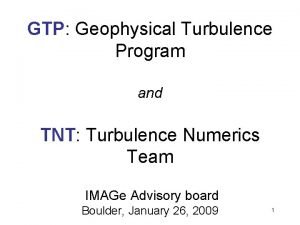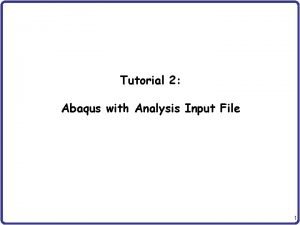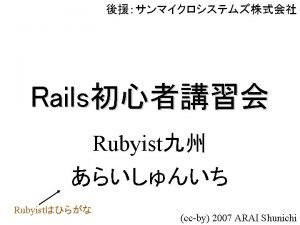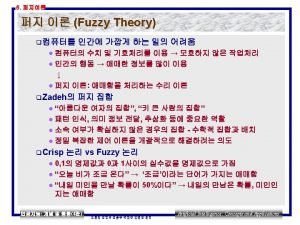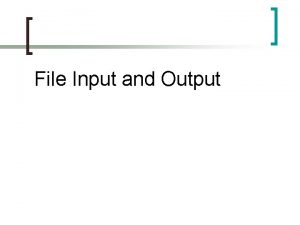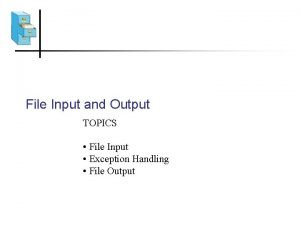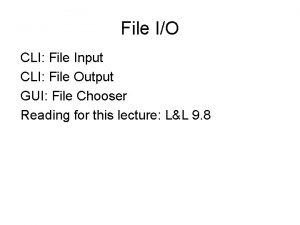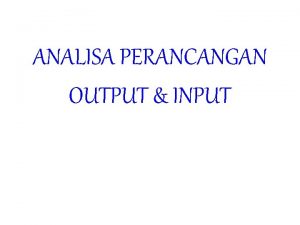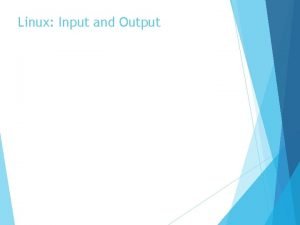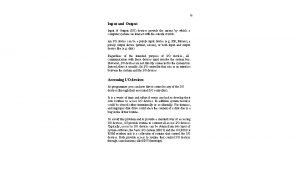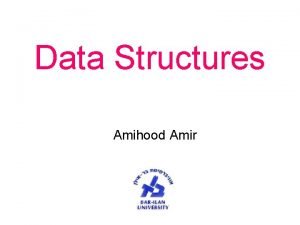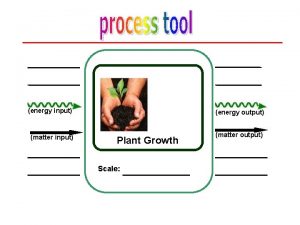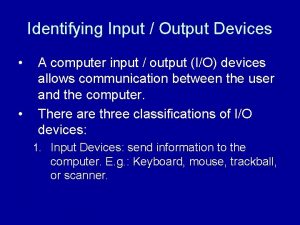File Input Output NCAR Command Language An Integrated


![ncl_filedump http: //www. ncl. ucar. edu/Document/Tools/ncl_filedump. shtml • ncl_filedump [-c] [-v var 1[, …]] ncl_filedump http: //www. ncl. ucar. edu/Document/Tools/ncl_filedump. shtml • ncl_filedump [-c] [-v var 1[, …]]](https://slidetodoc.com/presentation_image_h/2c6f131a793a4aea0bd229ad29bd71a4/image-3.jpg)


![net. CDF [NCL] Variable model X Scalar or Array attributes long_name _Fill. Value units net. CDF [NCL] Variable model X Scalar or Array attributes long_name _Fill. Value units](https://slidetodoc.com/presentation_image_h/2c6f131a793a4aea0bd229ad29bd71a4/image-6.jpg)




![Example: Read "T" across 5 files ["cat"] [Each file has 12 months] fils = Example: Read "T" across 5 files ["cat"] [Each file has 12 months] fils =](https://slidetodoc.com/presentation_image_h/2c6f131a793a4aea0bd229ad29bd71a4/image-11.jpg)
![addfiles: option ["join"] fils = systemfunc ("ls. /ann*. nc") f = addfiles (fils, "r") addfiles: option ["join"] fils = systemfunc ("ls. /ann*. nc") f = addfiles (fils, "r")](https://slidetodoc.com/presentation_image_h/2c6f131a793a4aea0bd229ad29bd71a4/image-12.jpg)




- Slides: 16

File Input / Output NCAR Command Language An Integrated Processing Environment Net. CDF 3/4 HDF-EOS 2/5 HDF 4/5 GRIB 1/2 Shapefile ASCII CCM Binary Input Compute X 11 PS EPS PDF SVG PNG NCGM Output Net. CDF 3/4 HDF ASCII Binary Fortran / C Dennis Shea National Center for Atmospheric Research NCAR is sponsored by the National Science Foundation

自我描述檔案 (self-described data)
![nclfiledump http www ncl ucar eduDocumentToolsnclfiledump shtml nclfiledump c v var 1 ncl_filedump http: //www. ncl. ucar. edu/Document/Tools/ncl_filedump. shtml • ncl_filedump [-c] [-v var 1[, …]]](https://slidetodoc.com/presentation_image_h/2c6f131a793a4aea0bd229ad29bd71a4/image-3.jpg)
ncl_filedump http: //www. ncl. ucar. edu/Document/Tools/ncl_filedump. shtml • ncl_filedump [-c] [-v var 1[, …]] [–h] file_name command line utility with options - provides textual overview of any supported file’s contents - behavior analogous to Unidata’s ncdump -h - file_name must have a file type suffix on command line -. nc. grb. hdfeos. he 5. h 5. ccm. shp [case insensitive] - suffix used as identifier only, actual file need not have - • ncl_filedump file_name. [grb/nc/hdfeos] - output can be sent to file or viewer via Unix redirection/ pipe ncl_filedump foo. grb > foo. txt [send to file] ncl_filedump foo. hdf | less [send to viewer]

addfile Opens a supported format Variables look like net. CDF (Grib, HDF-EOS) • f = addfile (file_name. ext, status ) • • file_name => any valid file name; string - ext => extension that identifies the type of file; string - § § § net. CDF: "nc" or "cdf" [read/write] HDF: "hdf" , "hdfeos”, "h 5”, "he 5" [read/write] GRIB: "grb" , "grib" [read only; GRIB 1 or GRIB 2] CCMHT: "ccm" [read only] SHAPE (GIS): ”shp" [read only] extension not required to be attached to file status [read/write status] "r", "c", "w" -f - § § reference/pointer to a single file; any valid variable name may have attributes (file attributes or global attributes) http: //www. ncl. ucar. edu/Document/Manuals/Ref_Manual/Ncl. Format. Support. shtml

Import Variable from Supported Fmt u = f->U read variable and all meta data into memory [structure] - no space allowed to left/right of -> [ fatal error] - use "$" syntax to represent variable name if type string - f = addfile ("foo. grb", "r") v. Nam = getfilevarnames (f) ; all variables on file or v. Nam = (/ ”SLP", ”T" /) ; manually specify do n=0, dimsizes(v. Nam)-1 x : = f->$v. Nam(n)$ ; $. . $ substitute string. . . end do u = (/ f->U /) - read data values only and _Fill. Value attribute
![net CDF NCL Variable model X Scalar or Array attributes longname Fill Value units net. CDF [NCL] Variable model X Scalar or Array attributes long_name _Fill. Value units](https://slidetodoc.com/presentation_image_h/2c6f131a793a4aea0bd229ad29bd71a4/image-6.jpg)
net. CDF [NCL] Variable model X Scalar or Array attributes long_name _Fill. Value units add_offset scale_factor etc. f = addfile(“foo. nc”, “r”) ; grb/hdf x = f->X NCL reads the scalar/array, attributes, and coordinate variables as an object X accessed via @ values coordinates time lev lat lon etc. Scalar or Array accessed via & attributes long_name _Fill. Value units add_offset scale_factor etc. coord var time lev lat lon etc.

Example: open, read, output net. CDF ; ----------------------fin = addfile ("in. nc, "r") ; open file and read in data u = fin->U ; import a variable (time, lev, lat, lon) fout = addfile("out. nc" , "c") ; create reference to output file fout@title = "I/O Example 1" ; add a global attribute to the file ; -----------------------; Output variable : ; -----------------------fout->U 2 = u ; output variable u to nc file

讀取大量檔案 (exercise 5) addfiles

addfiles (1 of 2) • span multiple supported files • q = addfiles (f. Names, "r") f. Names is a 1 D array of file names (strings) - can be used for any supported format - technically, "q" is a variable of type list - T = q[: ]->T ; [: ] read all files read T [with meta data] from each file in list ‘q’ - T must exist in each file and be same shape [rank] - a list is used to sequence results of addfiles - normal file variable selection is used with "[…]" - lat = q[0]->lat ; [0] read from first file Z = q[2: 6: 2]->Z ; extract Z only from files 2, 4, 6

addfiles • (2 of 2) 2 options on variable merging List. Set. Type (a, "cat") [default; "cat" => concatenation] - List. Set. Type (a, "join") - • when to use "cat" and "join" [rule of thumb] cat: continuous record - join: creating ensembles - § a record dimension will be added
![Example Read T across 5 files cat Each file has 12 months fils Example: Read "T" across 5 files ["cat"] [Each file has 12 months] fils =](https://slidetodoc.com/presentation_image_h/2c6f131a793a4aea0bd229ad29bd71a4/image-11.jpg)
Example: Read "T" across 5 files ["cat"] [Each file has 12 months] fils = systemfunc ("ls. /ann*. nc") f = addfiles (fils, "r") List. Set. Type(f, "cat") ; not necessary [default] T = f[: ]->T ; read T from all files print. Var. Summary(T) Variable: T Type: float Total Size: 5529600 bytes 1382400 values Attributes: 2 units: K long_name: temp Number of Dimensions: 4 Dimensions and sizes: [time|60] x [lev|5] x [lat | 48] x [lon | 96] Coordinates: time: [2349 … 4123] lat: [-87. 159. . 87. 159] lev: [85000 … 25000] lon: [0. . 356. 25]
![addfiles option join fils systemfunc ls ann nc f addfiles fils r addfiles: option ["join"] fils = systemfunc ("ls. /ann*. nc") f = addfiles (fils, "r")](https://slidetodoc.com/presentation_image_h/2c6f131a793a4aea0bd229ad29bd71a4/image-12.jpg)
addfiles: option ["join"] fils = systemfunc ("ls. /ann*. nc") f = addfiles (fils, "r") List. Set. Type (f, "join") T = f[: ]->T print. Var. Summary (T) Variable: T Type: float Total Size: 5529600 bytes 1382400 values Attributes: 2 units: K long_name: temperature Number of Dimensions: 5 Dim/sizes: [case | 5] x [time|12] x [lev|5] x [lat | 48] x [lon | 96] Coordinates: time: [2349 … 2683] lat: [-87. 159. . 87. 159] lev: [85000 … 25000] lon: [0. . 356. 25]


Reading Simple ASCII Table 1881 -999. 9 1882 -1. 7 1995 -1. 0 0. 2 -999. 9 -0. 5 0. 6 0. 1 -0. 8 0. 4 -1. 8 1. 5 -999. 9 0. 9 -1. 9 -3. 5 -1. 2 -0. 4 0. 6 -0. 2 -4. 6 -0. 1 0 2 5 8 1 3 4 6 7 ; read in data ncols = 9 nrows = 3 ksoi = asciiread ("ascii. in", (/nrows, ncols/), "float") ; partition total array into individual vector arrays yrs = ksoi(: , 0) mon 1 = ksoi(: , 1) data = ksoi(: , 1: ) ; all but leftmost column ; if you were going to plot/compute, must assign meta data@_Fill. Value = -999. 9 ; manually assign

Reading Binary/ASCII data • 7 functions for reading binary: fbinrecread: reads multiple unformatted sequential records [Fortran; ieee] - fbinnumrec: returns the number of unformatted sequential records [Fortran; ieee] - fbindirread: reads specified record from a Fortran direct access file [ieee] - fbinread: same as fbinrecread but reads only one ieee rec - craybinrecread: like fbinrecread but for COS blocked data - craybinnumrec: like fbinnumrec but for COS blocked data - cbinread: read binary created via C block IO function "write" - • 1 function for reading ASCII data: - asciiread [contributed. ncl: read. Ascii. Table] - use NCL str_* functions; Fortran/C to read complicated ASCII files • all above functions allow data to be shaped - x = fbinrecread ("foo_ieee", rnum, (/10, 20, 30/), "float") - a = asciiread ("foo_ascii", (/64, 128/) , "float")

Writing Binary/ASCII data • 4 procedures for writing (ieee) binary data fbinrecwrite: - fbindirwrite: - fbinwrite: - cbinwrite: - write unformatted fortran sequential recs write specified record; fortran direct access write a binary file containing a single record write binary file ; mimics C block IO "write“ • setfileoption: can be used to alter default behavior • 2 procedures to write ascii data - asciiwrite: write a file containing ASCII characters § writes a single flat ASCII file. One value per line. § No user control of format - write_matrix: write a multi-dim array to std out or to a file § user has format control … pretty-print § options for title and row numbering • use Fortran/C to write complicated ASCII files.
 Ncl ncar
Ncl ncar File-file yang dibuat oleh user pada jenis file di linux
File-file yang dibuat oleh user pada jenis file di linux Java file input output
Java file input output Java file input and output
Java file input and output Maurice blackmon
Maurice blackmon Rebecca haacker
Rebecca haacker Peter sullivan ncar
Peter sullivan ncar Unix multiple choice questions
Unix multiple choice questions Difference between logical file and physical file
Difference between logical file and physical file Fungsi dari create file pada operasi-operasi file (cont.)
Fungsi dari create file pada operasi-operasi file (cont.) Distributed file system definition
Distributed file system definition An html file is a text file containing small markup tags
An html file is a text file containing small markup tags In a file-oriented information system, a transaction file
In a file-oriented information system, a transaction file Abaqus input file format
Abaqus input file format V-file-input
V-file-input V-file-input
V-file-input V-file-input rules
V-file-input rules


